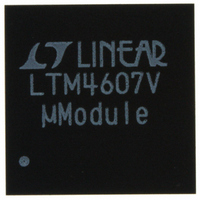LTM4607EV#PBF Linear Technology, LTM4607EV#PBF Datasheet - Page 13

LTM4607EV#PBF
Manufacturer Part Number
LTM4607EV#PBF
Description
IC BUCK/BOOST SYNC ADJ 5A 141LGA
Manufacturer
Linear Technology
Series
µModuler
Type
Point of Load (POL) Non-Isolatedr
Datasheet
1.LTM4607EVPBF.pdf
(26 pages)
Specifications of LTM4607EV#PBF
Design Resources
LTM4607 Spice Model
Output
0.8 ~ 24 V
Number Of Outputs
1
Power (watts)
120W
Mounting Type
Surface Mount
Voltage - Input
4.5 ~ 36 V
Package / Case
141-LGA
1st Output
0.8 ~ 24 VDC @ 5A
Size / Dimension
0.59" L x 0.59" W x 0.11" H (15mm x 15mm x 2.8mm)
Power (watts) - Rated
120W
Operating Temperature
-40°C ~ 85°C
Efficiency
98%
Lead Free Status / RoHS Status
Lead free / RoHS Compliant
3rd Output
-
2nd Output
-
Available stocks
Company
Part Number
Manufacturer
Quantity
Price
APPLICATIONS INFORMATION
pin for turning off the controller. If the pin is left open or
decoupled with a capacitor to ground, the SS pin is internally
provided with a starting current, permitting external control
for turning on the controller. If the pin is connected to a
voltage greater than 1.25V, the internal regulator (INTV
will be on even when the controller is shut down (RUN
pin voltage <1.6V). In this mode, the onboard 6V output
linear regulator can provide power to keep-alive functions
such as a keyboard controller.
INTV
An internal P-channel low dropout regulator produces 6V
at the INTV
the control chip and internal circuitry within the module.
The LTM4607 also provides the external supply voltage pin
EXTV
5.7V, the internal regulator is turned off and an internal
switch connects the EXTV
supplying internal power. The switch remains closed as long
as the voltage applied to EXTV
allows the MOSFET driver and control power to be derived
from the output when (5.7V < V
internal regulator when the output is out of regulation (start-
up, short-circuit). If more current is required through the
EXTV
can be interposed between the EXTV
Ensure that EXTV
The following list summarizes the three possible connec-
tions for EXTV
1. EXTV
2. EXTV
3. EXTV
to be powered from the internal 6V regulator at the cost
of a small efficiency penalty.
This is the normal connection for a 6V regulator and
provides the highest efficiency.
supply is available in the 5.5V to 7V range, it may be
used to power EXTV
the MOSFET gate drive requirements.
CC
CC
CC
. When the voltage applied to EXTV
and EXTV
CC
CC
switch than is specified, an external Schottky diode
CC
left open (or grounded). This will cause INTV
connected directly to V
connected to an external supply. If an external
CC
pin from the V
CC
:
CC
CC
≤ V
CC
IN
CC
.
provided it is compatible with
IN
pin to the INTV
CC
supply pin. INTV
remains above 5.5V. This
OUT
OUT
CC
< 7V) and from the
(5.7V < V
and INTV
CC
CC
rises above
pin thereby
CC
OUT
CC
powers
< 7V).
pins.
CC
CC
)
Thermal Considerations and Output Current Derating
In different applications, LTM4607 operates in a variety
of thermal environments. The maximum output current is
limited by the environmental thermal condition. Sufficient
cooling should be provided to ensure reliable operation.
When the cooling is limited, proper output current de-
rating is necessary, considering ambient temperature,
airflow, input/output condition, and the need for increased
reliability.
The power loss curves in Figures 5 and 6 can be used
in coordination with the load current derating curves in
Figures 7 to 14 for calculating an approximate θ
the module. Column designation delineates between no
heat sink, and a BGA heat sink. Each of the load current
derating curves will lower the maximum load current as
a function of the increased ambient temperature to keep
the maximum junction temperature of the power module
at 115°C allowing a safe margin for the maximum operat-
ing temperature below 125°C. Each of the derating curves
and the power loss curve that corresponds to the correct
output voltage can be used to solve for the approximate
θ
characteristics is provided in the thermal application note
for the LTM4607.
DESIGN EXAMPLES
Buck Mode Operation
As a design example, use input voltage V
V
Set the PLLFLTR pin at 2.4V or more for 400kHz frequency
and connect FCB to ground for continuous current mode
operation. If a divider is used to set the frequency as shown
in Figure 16, the bottom resistor R3 is recommended not
to exceed 1kΩ.
To set the output voltage at 12V, the resistor R
pin to ground should be chosen as:
JA
OUT
R
of the condition. A complete explanation of the thermal
FB
= 12V and ƒ = 400kHz.
=
V
0.8V • 100k
OUT
− 0.8V
≈ 7.15k
LTM4607
IN
= 12V to 36V,
FB
from V
13
JA
4607fb
for
FB















